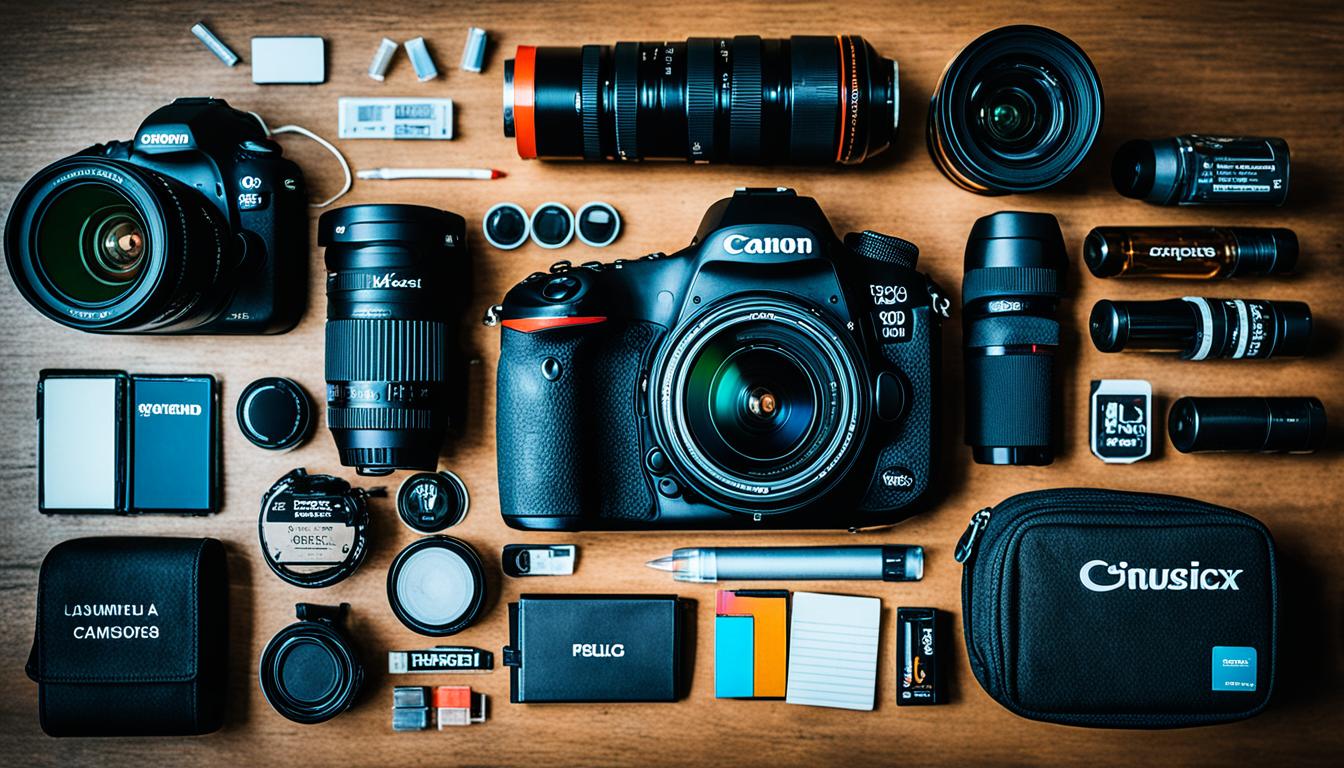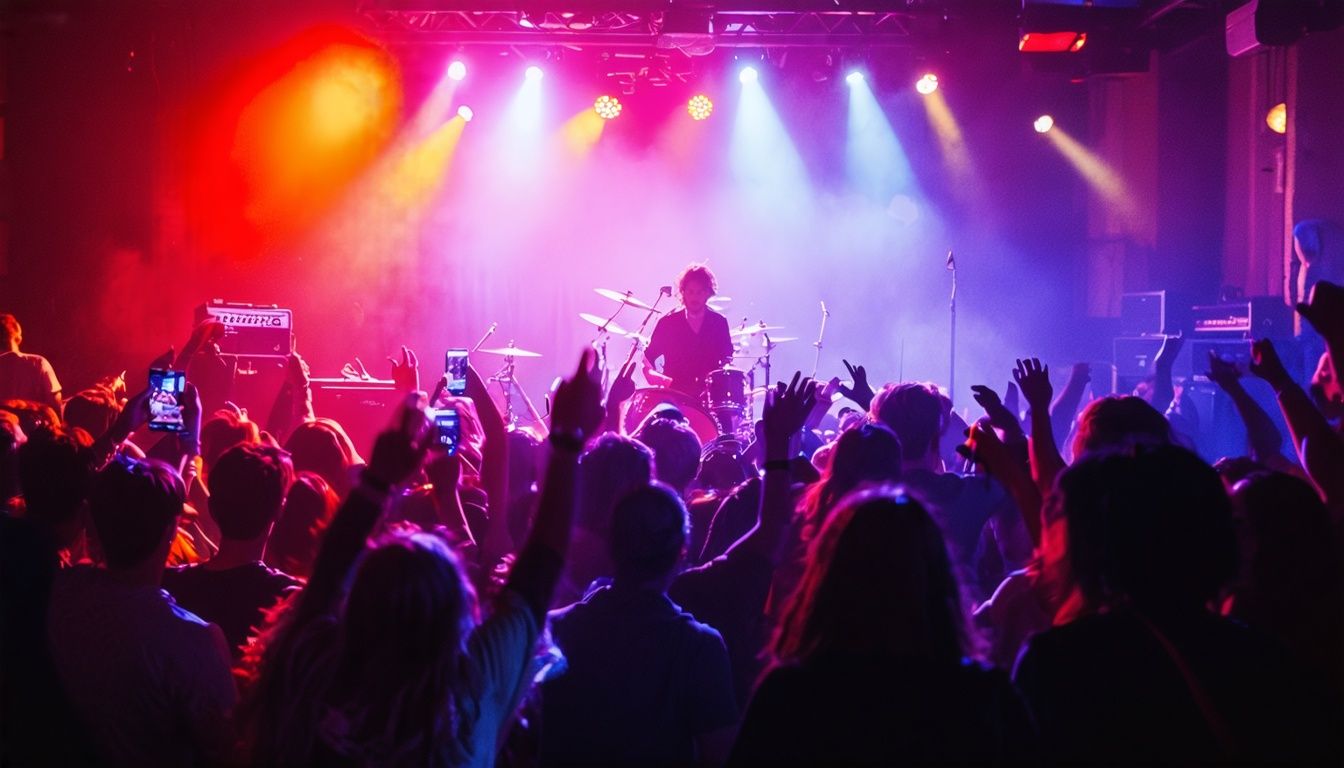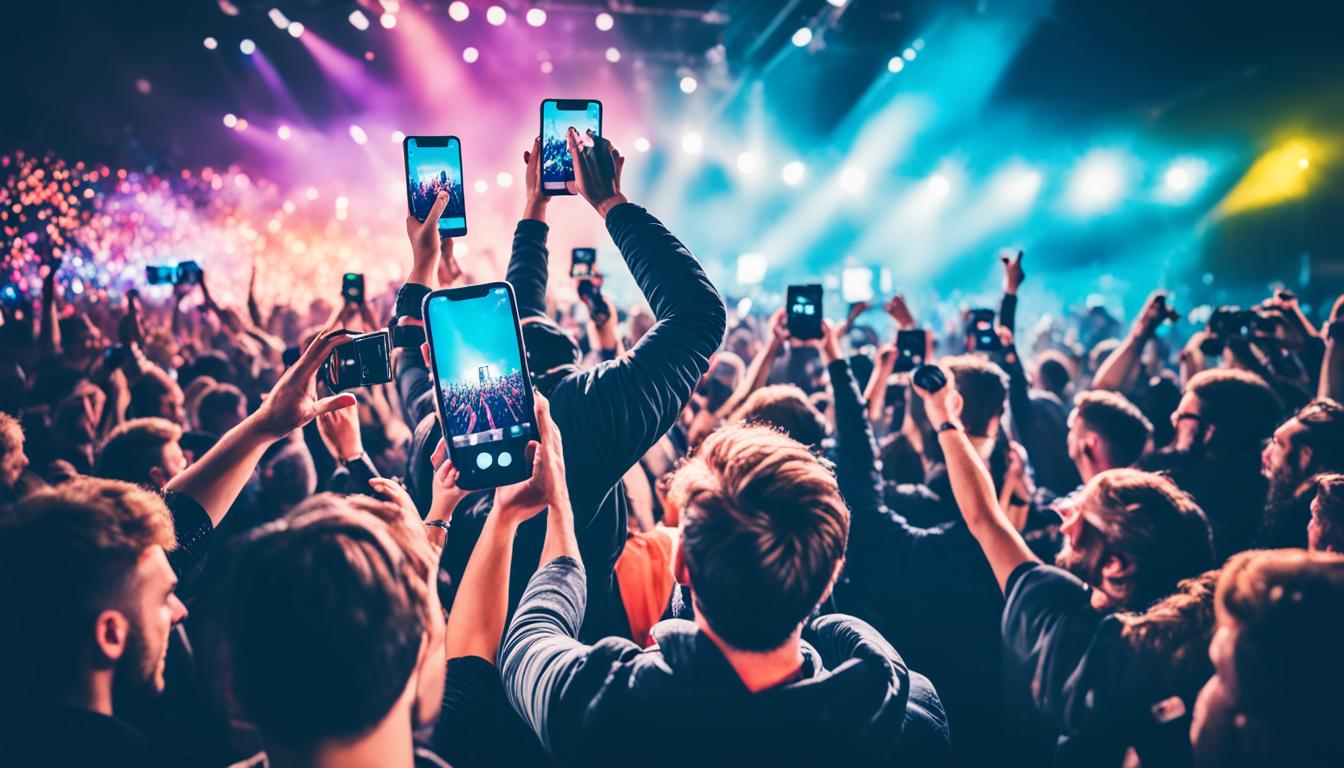The electric world of live music draws us in with its vibrant stories. Capturing concerts is about recording the energy and passion from the stage and the crowd. Having the best cameras and gear ensures we catch every fleeting moment.
Our journey has shown us how crucial the right equipment is amidst the roaring music and moving crowds. After many tests and gigs, we’ve learned mirrorless systems like the Nikon Z 9 are ideal. They offer the perfect blend of speed, high resolution, and advanced autofocus—key for concert photography.
Concert photography isn’t one approach fits all. Depending on the shot, we might use the high-resolution Nikon Z 7 or the portable Nikon Z 50 for vibrant video captures. Not to mention, fast-aperture zoom lenses and essentials like the Delkin 128 GB BLACK CFexpress cards. And the Black Rapid Double Strap is crucial for moving around smoothly.
Key Takeaways
- Choosing the right gear essentials for concert photography can transform your live music storytelling.
- A mirrorless camera like the Nikon Z 9 combines speed, resolution, and autofocus necessary for low-light concert environments.
- Secondary cameras such as the Nikon Z 7 and Z 50 diversify our capabilities, especially in video recording and discrete shooting.
- Fast-aperture zoom lenses provide versatility, covering wide angles to telephoto without sacrificing low-light performance.
- Memory cards with high-speed capabilities and dual-camera straps optimize our efficiency and mobility during concerts.
Understanding the Concert Photography Environment
Stepping into concert photography, we face the thrill of shooting in low light. Each venue presents different lighting challenges. It tests our skill in adapting camera settings for concert photography.
Concert photography accessories
are crucial. They help us overcome these challenges and excel.
The Challenges of Low-Light Event Spaces
Concerts often have dim lighting, making photography tricky. We rely on our cameras, setting high ISOs to capture clear images. Using lenses with wide apertures helps us make the most of the little light available. This way, we keep the shots full of energy and drama.
Navigating Crowds and Dynamic Performances
Dealing with moving crowds and performers requires nimble accessories. A fast autofocus is essential for catching every vibrant moment. Being patient and well-placed helps us navigate through fans and onstage action.
Maximizing Limited Shooting Durations
Shooting time at concerts is often short, only a few songs. Thus, every moment and setting counts. We must be quick to capture the perfect image in these brief periods. Knowing our camera well helps us not miss a beat.
| Accessory | Function | Benefit in Low-Light |
|---|---|---|
| Fast prime lens | Maximizes aperture | Enhanced light capture |
| High-speed memory card | Quicker write speeds | Ensures rapid sequence shooting |
| Monopod or handheld rig | Stabilization | Reduces camera shake in low light |
| Camera strap/harness | Equipment management | Quick access and weight distribution |
With the right settings and accessories, we’re ready to capture the night’s magic. Concert photography is more than taking pictures. It’s about feeling the music and capturing it with anticipation, precision, and creativity.
Choosing the Right Camera for Concert Photography
When you’re into concert photography, picking the right must-have gear for concert photography is crucial. It turns you from a hobbyist into a pro. The camera is key in this journey. Here’s how to make a wise choice for capturing those unforgettable concert moments.

The Nikon D750 and Canon EOS 6D are top picks for many. They excel in low-light performance and deliver sharp, high-res images. Their big sensors capture all the details of live shows, even in low light. These cameras are essential for concert photography.
But, there are also smaller, cheaper options like the Canon 80D and Nikon D500. They have smaller sensors but still take great photos in dim light. They might not beat full-frame cameras in very low light, but they’re still great. They mix affordability with quality.
Lately, mirrorless cameras like the Sony A7III have changed the game. They are light and easy to carry, perfect for moving around at concerts. They focus quickly, keep noise low at high ISOs, and are great for concert photos.
Mirrorless cameras can shoot up to 10 RAW frames per second with great autofocus. This makes them exciting for concert photography. They are becoming popular with photographers who like their light design and high performance.
We believe the magic of concert photography lies not just in the moment captured but also in the seamless fusion between the photographer and their gear. Choosing the right camera encompasses a balance between the intimate knowledge of your top lenses for concert photography, the ambience you wish to immortalize, and the tools you employ to do so.
- Nikon D750: A full-frame gem excelling in low-light capture
- Canon EOS 6D: High resolution and superior performance in the dark
- Canon 80D: The economical contender with enviable features
- Nikon D500: A compact ally in the tireless pursuit of quality photos
- Sony A7III: Mirrorless innovation with exceptional ISO performance
When we dive into the music at a concert, it’s the top lenses for concert photography and our cameras that let us capture the energy forever. This blend of tech captures the spirit of music in photos that last a lifetime.
Gear Essentials for Concert Photography
Taking photos at concerts means capturing live moments with skill. You have to deal with low light and constant movement. To face these challenges, we’ve made a crucial list of concert photography gear. This list highlights the best concert photography equipment needed to catch every exciting moment clearly and creatively.
Full-Frame Versus Crop Sensor DSLRs
Choosing between full-frame and crop sensor DSLRs is key. It depends on what we want to achieve with our photos. Full-frame DSLRs capture wider scenes and work well in low light. They help us get detailed images and soft light effects. Crop sensor DSLRs are lighter and offer a deeper view. They’re easier to handle in crowded spaces.

Why Mirrorless Cameras Offer an Edge
Mirrorless cameras are changing the game for concert photography equipment. They are small but powerful, making it easy to move through crowds. These cameras can take quick shots without delay. They also work well in dim light without making much noise. This is why they’re becoming a favorite for concert photographers.
Top Picks: Best Cameras for Concert Photography
In our quest for the best concert photography gear, some cameras stand out. The Nikon Z 9 is excellent for fast RAW shooting and high-quality images. Alongside, the Nikon Z 7 is great for keeping photo quality high at various ISO levels. For those needing a light camera that’s good for videos, the Nikon Z 50 is perfect. It’s a key part of our selected concert photography equipment.
Lenses: Prime Versus Zoom for Music Events
Choosing the right lens is crucial in concert photography. Prime lenses let in more light. This is perfect for dimly lit music venues. The 50mm f/1.8 prime lens, for example, is great for sharp, clear photos with a soft background. This effect makes your subject stand out beautifully.
Zoom lenses, like Nikon’s 14-24mm, 24-70mm, and 70-200mm f/2.8, offer flexibility. They let you quickly adjust to different scenes without changing lenses. While prime lenses have a wider aperture, zoom lenses like these don’t compromise on low-light performance. They maintain a consistent f/2.8 aperture across all zoom ranges.
Finding the perfect balance is key. You might use a 35mm f/1.4 for close-ups or a 70-200mm f/2.8 for full-stage shots. The goal is to capture the energy of live music. The best camera settings and lenses can make your photos as vibrant and emotional as the live event.
FAQ
What are the gear essentials for concert photography?
A reliable camera is key for concert photography. Look for one with great low-light performance. Full-frame DSLRs or mirrorless cameras are best. It also helps to have prime lenses for low light and zoom lenses for various shots. Don’t forget high-speed memory cards and comfy straps for your gear.
What challenges do photographers face in low-light event spaces?
Low-light spaces make it tough to get clear pictures. You’ll need a camera that performs well with high ISO. Fast lenses help use the light we have. And your camera should focus fast in changing light, like at concerts.
How can photographers effectively navigate crowds and dynamic performances?
Cameras that focus quickly and are easy to handle are a must. You’ll want zoom lenses for flexibility and good straps to keep your gear safe. This way, you can move easily and catch the best shots, even in a crowd.
What strategies can be used to maximize limited shooting durations at concerts?
Know your gear well and plan for key moments. Being in the right place helps. Use continuous shooting mode to not miss anything. This is crucial when you only have a short time to shoot.
What are the considerations when choosing the right camera for concert photography?
Look for cameras with good low-light ability and fast autofocus. Think about if you want a DSLR or a more compact mirrorless camera. The Nikon Z 9 and Sony A7III are great choices because they’re fast and perform well in low light.
Full-frame versus crop sensor DSLRs for concert photography – which is better?
Full-frame cameras do better in low light and have a wider view. They’re good for capturing detailed shots at concerts. Crop sensor cameras are smaller and cheaper but not as good in low light. The right choice depends on what you need and your budget.
Why do mirrorless cameras offer an edge in concert photography?
Mirrorless cameras are small, fast, and take great photos in high ISOs with less noise. They’re also good for video. This makes them perfect for moving around easily and quietly at concerts.
What are the top picks for the best cameras for concert photography?
The Nikon Z 9 is a top pick for its speed and image quality. The Sony A7III is also great for its focus and performance in low light. The Nikon Z 7 and Z 50 are also good for their versatility in images and video.
Why would a photographer choose prime lenses over zoom lenses for music events?
Prime lenses have wider apertures, letting in more light. This is key in dim settings. They also give clearer images and a dramatic background blur.
How do zoom lenses benefit concert photographers?
Zoom lenses allow shooting at various distances without changing lenses. They’re versatile for capturing different angles quickly. This is especially helpful in the unpredictable environment of a concert.



